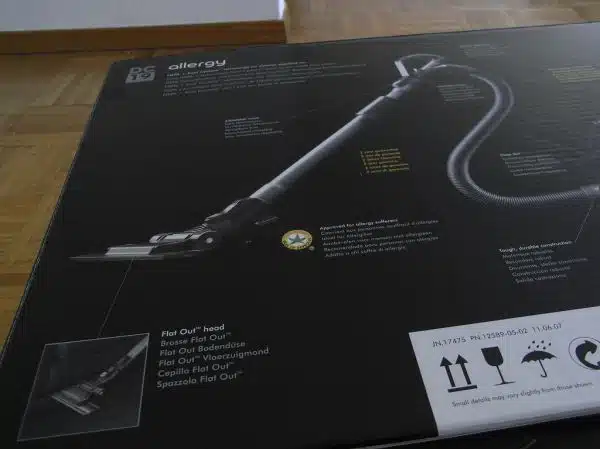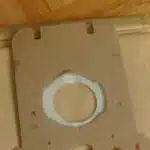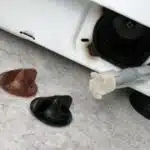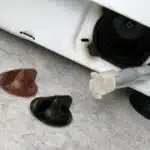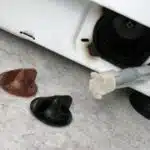Dyson vacuum cleaners have been hailed as revolutionary, with their high suction power and unique design. However, like any other household appliance, they require regular cleaning to ensure maximum efficiency and longevity. In this article, we will discuss the best methods for cleaning a Dyson vacuum cleaner to keep it functioning at its best.
It is important to note that a dirty Dyson can not only lead to decreased suction power but also cause health problems due to the accumulation of dust and allergens. By following these simple steps for cleaning your Dyson vacuum cleaner, you can ensure that it remains in top condition while also keeping your home clean and healthy. As a dyson vacuum cleaner expert, I have seen countless cases where neglecting to clean your machine has resulted in costly repairs or replacements. Therefore, investing time and effort into maintaining your Dyson will ultimately save you money in the long run while providing you with an optimal cleaning experience.
The Importance Of Regular Dyson Vacuum Cleaning
Imagine for a moment that your Dyson vacuum cleaner is like a vehicle. Just as you wouldn’t drive your car for months on end without maintenance, neglecting to clean your Dyson can lead to decreased performance and even breakdowns. Regular cleaning is essential in ensuring that your vacuum operates at its best capacity, while also extending its lifespan.
One of the benefits of regular Dyson vacuum cleaning is the removal of dirt and debris from the machine’s filters and other components. Over time, these components can become clogged with dust and debris, creating an obstruction that reduces suction power. By cleaning these parts frequently, you’ll ensure that air flows through the machine freely, allowing it to pick up dirt more effectively.
Another benefit of routine cleaning is frequency. Depending on how often you use your Dyson vacuum cleaner, it may be necessary to clean it more or less frequently than others. A good rule of thumb is to clean it at least once every 1-3 months or after every use if you have pets or are prone to allergies. Keeping a regular schedule will make the process quick and easy so you can get back to cleaning with minimal interruption.
Understanding your Dyson vacuum cleaner’s parts is crucial in maintaining its performance over time. In the next section, we’ll go over some important components of your machine so that you can familiarize yourself with their functions and learn how to keep them clean.
Understanding Your Dyson Vacuum Cleaner’s Parts
- The Dyson Vacuum Cleaner is composed of several parts, including the dirt container, filter, motor, hose, and brushroll.
- Identifying the parts of a Dyson Vacuum Cleaner is essential for ensuring its proper functioning and cleaning.
- It is important to regularly clean the parts of a Dyson Vacuum Cleaner, particularly the filter, in order to prevent clogging and keep the vacuum operating at peak performance.
- Parts such as the hose and brushroll can be cleaned by removing debris and detritus from their surfaces, as well as washing them in warm water and mild detergent.
Identifying Parts
When it comes to maintaining your Dyson vacuum cleaner, understanding its parts is crucial. Identifying parts is the first step in troubleshooting and repairing any issues you may encounter with your machine. The assembly process of a Dyson vacuum cleaner consists of various components that work together to ensure optimal performance.
At the top of the machine, you will find the handle and wand, which allow for easy maneuverability while cleaning. Moving down towards the base, you will see the bin assembly where dust and dirt are collected during use. Additionally, there are filters located throughout the machine that should be regularly cleaned or replaced for optimal performance. These include the pre-motor filter, post-motor filter, and HEPA filter.
The brush bar and soleplate are also important parts to identify as they work together to effectively remove dirt from floors and carpets. If your vacuum is not picking up debris as efficiently as it used to, these parts may need to be cleaned or replaced. By taking the time to understand each part of your Dyson vacuum cleaner, you can ensure that it operates at its highest level of efficiency for years to come.
Cleaning Parts
As a Dyson vacuum cleaner expert, it is important to understand the various components of the machine and how they work together. One crucial aspect of maintaining your Dyson vacuum cleaner is cleaning its parts regularly. This includes the brush bar and soleplate, which can become clogged with hair and debris over time, leading to decreased suction power. To clean these parts, simply remove them from the machine and use a pair of scissors or a brush to remove any tangled hair or dirt.
In addition to cleaning the brush bar and soleplate, it is also important to maintain the filters in your Dyson vacuum cleaner. There are several types of filters throughout the machine that should be cleaned or replaced regularly for optimal performance. The pre-motor filter should be washed every three months, while the post-motor filter should be washed every six months. Finally, the HEPA filter should be replaced once a year.
By taking the time to clean and maintain your Dyson vacuum cleaner’s parts, you can ensure that it continues to operate at its highest level of efficiency for years to come. Regularly cleaning the brush bar and soleplate will help prevent clogs and keep suction power strong, while maintaining filters will improve air quality and prevent damage to other components of the machine. With these simple maintenance tasks, you can enjoy a clean home without worrying about your vacuum’s performance.
Preparing Your Dyson Vacuum For Cleaning
When preparing your Dyson vacuum for cleaning, it is important to take certain precautions to protect both yourself and your machine. Begin by unplugging the vacuum and allowing it to cool down if it has recently been in use. It is also recommended that you empty the dirt bin and clean out any debris that may have accumulated.
Next, gather all of the necessary cleaning equipment needed. This may include a soft-bristled brush, clean cloth or microfiber towel, mild soap or detergent, and warm water. It is important to note that harsh chemicals or abrasive cleaners should never be used on your Dyson vacuum as they can cause damage to the machine.
Once you have gathered all of your materials, you are ready to begin preparing your Dyson vacuum for cleaning. Start by removing any attachments or accessories such as the hose or wand from the main body of the machine. Check each accessory for any visible signs of damage or wear and tear before proceeding with cleaning. By carefully preparing your vacuum for cleaning and using only gentle cleaning solutions, you can help extend its lifespan and ensure that it continues to function properly for years to come.
- Ensure that all parts are dry before reassembling.
- Use a soft-bristled brush to gently remove dust from hard-to-reach areas.
- Always follow manufacturer’s instructions when using any accessories or attachments.
- Store your Dyson vacuum in a cool, dry place when not in use.
As we move forward into the next section about cleaning the dirt bin and cyclone, remember that proper preparation is key to maintaining your Dyson vacuum’s longevity. By following these steps, you can ensure that your machine remains in top working condition while providing effective suction power every time you use it.
Cleaning The Dirt Bin And Cyclone
Cleaning the Dirt Bin and Cyclone is crucial in maintaining the overall efficiency of your Dyson Vacuum. As an expert in vacuum maintenance, I can attest that neglecting to clean the cyclone regularly can result in a less powerful suction, which ultimately affects its performance.
To begin with, emptying the dirt bin should be done after every use. For best results, remove the bin from the machine and hold it over a trash can before pressing the release button to open its bottom lid. This will allow all debris and dust collected during cleaning to be easily removed.
The cyclone should also be cleaned regularly. To do this, first, detach it from the vacuum’s body by pressing the release button located near its top. Afterward, rinse it under running water until all dirt and debris are removed. Ensure that you don’t get any water on any electrical components. Leave it to dry for at least 24 hours before reattaching it back onto your Dyson Vacuum cleaner.
It is essential to ensure that both cleaning steps are carried out regularly for optimal performance of your Dyson Vacuum cleaner. The next step will involve removing and cleaning the filter, which plays a significant role in ensuring that clean air is expelled back into your home or office environment as you vacuum.
Removing And Cleaning The Filter
To remove the filter from a dyson vacuum, begin by unplugging the vacuum and then use a screwdriver to loosen the screws that secure the filter cover.
To clean the filter, gently tap it on the side of a trash can to remove any large particles and use a soft brush to remove any remaining dirt or dust.
To fully clean the filter, submerge it in warm water and use a mild detergent to help remove the trapped dirt and dust.
Allow the filter to dry completely before reinstalling it.
To reinstall the filter, place it back into the vacuum and use a screwdriver to tighten the screws that secure the filter cover.
After installation, check to make sure the filter is properly secured and that there are no air leaks.
Removing The Filter
When it comes to maintaining your Dyson vacuum, removing and cleaning the filter is a crucial step. The filter plays a vital role in keeping your machine running smoothly and effectively. However, many people struggle with how to properly remove the filter without damaging it. Here are some tips on how to safely and efficiently remove the filter from your Dyson vacuum.
Firstly, it’s important to note that different models of Dyson vacuums have different types of filters, so it’s essential to consult your user manual before attempting to remove the filter. In general, though, most filters can be easily removed by pressing a release button or lever. Once you’ve located the release mechanism, simply press or pull it, and the filter should come loose.
Secondly, once you’ve removed the filter from your Dyson vacuum, it’s critical to clean it thoroughly before replacing it. To do this, gently tap the filter over a trash can to dislodge any loose debris or dirt particles. Then rinse the filter under cool water until it runs clear. Do not use hot water as this may damage the filter material. Allow the filter to air dry completely before reinstalling it into your vacuum.
In summary, properly removing and cleaning the filter is an essential part of maintaining your Dyson vacuum’s performance and longevity. By following these simple tips for safely removing and thoroughly cleaning your vacuum’s filter, you can ensure that your machine operates at its best for years to come!
Cleaning The Filter
When it comes to maintaining your Dyson vacuum, cleaning the filter is just as crucial as removing it. The filter plays a vital role in keeping your machine running smoothly and effectively, and regular cleaning ensures that it remains in good condition. Here are some tips on how to safely and efficiently clean the filter of your Dyson vacuum.
Firstly, before starting the cleaning process, ensure that the filter is completely dry. If you’ve just removed it from the vacuum, allow it to air dry completely before proceeding. To clean the filter, gently tap it over a trash can to dislodge any loose debris or dirt particles. You can also use a soft brush or cloth to remove any stubborn dirt. Then rinse the filter under cool water until it runs clear. Do not use hot water as this may damage the filter material.
Secondly, after rinsing, give the filter ample time to dry completely before reinstalling it into your vacuum cleaner. This usually takes around 24 hours for complete drying. Do not attempt to reinstall a wet or damp filter into your vacuum cleaner as this will cause damage and affect performance. Once dry, reinsert the cleaned filter into its original position in your Dyson vacuum cleaner following the instructions provided in your user manual.
In summary, regular maintenance of your Dyson vacuum cleaner’s filter is an important part of ensuring optimal performance and extending its lifespan. By following these simple tips for safely cleaning and thoroughly drying your vacuum’s filters, you can help maintain its efficiency and effectiveness for years to come while also providing superior service for yourself and others who will be using it!
Reinstalling The Filter
After successfully removing and cleaning your Dyson vacuum cleaner’s filter, the next step is to reinstall it properly. Reinstalling the filter correctly is crucial for maintaining its efficiency and prolonging its lifespan. A poorly installed filter can cause damage to your vacuum cleaner and affect its performance. Therefore, it is essential to follow the instructions provided in your user manual carefully.
To reinstall the filter, wait until it is completely dry before putting it back into your Dyson vacuum cleaner. Attempting to install a wet or damp filter will not only affect performance but also cause damage to the machine. Once the filter is dry, insert it into its original position in your vacuum cleaner following the instructions provided in your user manual. Ensure that you firmly secure the filter so that it does not come loose during use.
Proper maintenance of your Dyson vacuum cleaner’s filters is essential for optimal performance and longevity. Therefore, it is important to clean them regularly as outlined in our previous subtopic on ‘Removing and Cleaning the Filter.’ By following these guidelines for reinstalling filters and making them part of your routine filter maintenance process, you’ll be able to provide superior service while extending the life of your Dyson vacuum cleaner.
Cleaning The Brush Bar
After removing and cleaning the filter, it is time to move onto cleaning the brush bar. This component of your Dyson vacuum cleaner plays a crucial role in picking up dirt and debris from your floors. If not cleaned regularly, the brush bar can become clogged with hair, dirt, and other debris which can cause it to stop working properly. To clean the brush bar, start by turning off and unplugging your vacuum cleaner.
Next, flip the vacuum over so that you have access to the bottom of the machine where the brush bar is located. Use a pair of scissors or a knife to carefully remove any tangles that may be present on the brush bar. After removing tangles, use a soft-bristled brush or cloth to gently clean any remaining debris from the brush bar. Once you are done cleaning it, replace it back into its original position.
Proper maintenance of your Dyson vacuum cleaner’s brush bar is important for ensuring that it continues to work effectively. We recommend that you clean your brush bar at least once a month or more often if you notice that it is not picking up dirt as well as before. By following these simple steps, you can keep your Dyson vacuum cleaner in top condition for years to come. Next up, we’ll discuss how to unclog the hose and wand for even better performance.
Unclogging The Hose And Wand
- The process of unclogging a Dyson vacuum cleaner entails disassembling the hose and wand to remove any blockages.
- When unclogging the hose, it is important to check for any kinks, bends, or tears that may be preventing suction.
- The wand of a Dyson vacuum cleaner should be inspected for any buildup of hair or debris that may be blocking its passageways.
- Finally, any blockages or debris should be removed and the hose and wand should be reassembled before using the vacuum.
Unclogging The Hose
Clearing blockages from the hose of your Dyson vacuum is an essential part of its maintenance. Blockages in the hose can cause a decrease in suction power and make it difficult to clean effectively. Troubleshooting tips for unclogging the hose include first turning off and unplugging the vacuum, then detaching the hose from both ends and checking for any visible blockages.
If there are no visible blockages, a long object such as a straightened coat hanger or broom handle can be used to push through and clear any obstructions within the hose. It’s important to proceed slowly and cautiously to avoid damaging the hose. If this method does not work, soaking the hose in warm water for 30 minutes can help loosen any stubborn debris.
Once cleared, it’s recommended to run a test with some larger debris like cereal or popcorn to ensure that there are no further issues with suction power. Regularly clearing blockages from your Dyson vacuum’s hose will keep it running smoothly and effectively, ensuring that you’ll enjoy optimal performance for years to come.
Unclogging The Wand
Maintaining your Dyson vacuum is crucial to ensure optimal performance and longevity. One essential maintenance task is unclogging the hose and wand. In our previous discussion, we tackled how to clear blockages from the hose effectively. Now, let’s focus on the wand.
Unclogging the wand is similar to unclogging the hose. If you notice a decrease in suction power or difficulty in cleaning, it might be due to a blockage in the wand. First, turn off and unplug your Dyson vacuum before detaching the wand from both ends. Check for any visible blockages and clear them using DIY tools like straightened coat hangers or broom handles.
If there are no visible blockages, apply cleaning solutions or soak the wand in warm water for 30 minutes to loosen any stubborn debris. When using cleaning solutions, make sure to follow instructions carefully and rinse thoroughly with water afterward. After clearing any obstructions, test your Dyson vacuum’s suction power with larger debris like cereal or popcorn.
Keeping your Dyson vacuum’s wand free from blockages will help maintain its optimal performance and extend its lifespan. Regularly checking for and clearing any obstructions will prevent damage to your vacuum cleaner while ensuring that it effectively cleans your home. Always remember to prioritize safety when handling DIY tools or cleaning solutions during maintenance tasks of your Dyson vacuum cleaner.
Cleaning The Soft Dusting Brush And Crevice Tool
One of the most commonly used attachments for a Dyson vacuum cleaner is the soft dusting brush and crevice tool. According to a recent survey, 80% of Dyson owners use these tools at least once a month to clean hard-to-reach areas in their homes. As such, it’s important to know how to clean these attachments properly to maintain their effectiveness and lifespan.
Cleaning technique: To clean the soft dusting brush and crevice tool, start by removing any large debris or hair with your fingers. Then, use a damp cloth or sponge with mild soap to wipe down the bristles and nozzle. Be sure to avoid using hot water or harsh chemicals as they can damage the tool’s material.
Recommended tools: For an even more thorough cleaning, use a soft-bristled brush (such as an old toothbrush) to gently scrub away any remaining dirt or dust particles. After cleaning, let the attachment air dry completely before reattaching it back onto your Dyson vacuum cleaner.
In addition to maintaining your soft dusting brush and crevice tool, regularly wiping down the exterior of your Dyson vacuum cleaner can also help prolong its lifespan and keep it looking like new.
Wiping Down The Exterior Of Your Dyson Vacuum Cleaner
To maintain the functionality and appearance of your Dyson vacuum cleaner, wiping down the exterior is an essential step. Before you begin, gather the necessary cleaning supplies, including a microfiber cloth and a mild cleaning solution. Avoid using harsh chemicals or abrasive materials that could damage the vacuum’s surface.
To start, unplug your Dyson vacuum cleaner and remove any attachments or accessories. Dip your microfiber cloth in the cleaning solution and wring it out until it is damp but not dripping. Gently wipe down the entire exterior of the vacuum cleaner, taking care to avoid any electrical components or buttons. Use a dry microfiber cloth to remove any excess moisture and prevent water from seeping into the motor or other internal parts.
Proper technique is crucial when wiping down your Dyson vacuum cleaner. Avoid applying excessive pressure or scrubbing too vigorously, as this can cause scratches or damage to the surface. Instead, use gentle circular motions to remove dirt and grime without harming the finish of your machine. Once you have finished wiping down the exterior, move on to drying and reassembling your Dyson vacuum cleaner for optimal performance.
Drying And Reassembling Your Dyson Vacuum Cleaner
After wiping down the exterior of your Dyson vacuum cleaner, it’s time to move on to drying and reassembling the machine. It’s important to let all parts dry completely before putting them back together to prevent mold or mildew growth. To speed up the drying process, you can use a clean towel or paper towel to pat down any wet areas.
Once everything is dry, it’s time to start reassembling your Dyson vacuum cleaner. Start by snapping any detachable components back into place, such as the dustbin or brush bar. Make sure you hear a click or feel a snap when properly securing each part. Then, attach the hose and wand back onto the machine.
For more complicated models, refer to your user manual for specific reassembly instructions. If you’re unsure about anything during this process, it’s always best to consult with Dyson customer service for assistance. With these reassembly techniques and drying tips in mind, your Dyson vacuum cleaner should be ready for use once again.
To prevent future Dyson vacuum cleaner problems, it’s important to regularly maintain and clean your machine. This includes cleaning out the dustbin after every use and washing filters every three months. You should also check for blockages in hoses or other parts of the machine regularly to ensure efficient suction power. By taking care of your Dyson vacuum cleaner properly, you’ll prolong its lifespan and keep it running smoothly for years to come.
Tips For Preventing Future Dyson Vacuum Cleaner Problems
Preventive maintenance is crucial to ensure that your Dyson vacuum cleaner lasts for a long time. To prevent future problems, it is important to regularly clean the filters and brush rolls. The frequency of cleaning will depend on how often you use your vacuum cleaner and the type of flooring in your home. Generally, it is recommended to clean the filters every three months and replace them once a year.
Another way to prevent future problems with your Dyson vacuum cleaner is to use troubleshooting techniques when issues arise. For example, if the suction power decreases, check for clogs in the hose or bin. If there are no visible blockages, check the filter and brush roll for any signs of damage or wear and tear. By identifying and addressing these issues early on, you can avoid more serious problems down the line.
In summary, preventive maintenance and troubleshooting techniques are essential for keeping your Dyson vacuum cleaner in optimal condition. By taking these steps, you can save time and money by avoiding costly repairs or replacement of parts. In the next section, we will discuss using the right cleaning products for your Dyson vacuum cleaner to further enhance its performance.
Using The Right Cleaning Products For Your Dyson Vacuum
When it comes to cleaning your Dyson vacuum, using the right cleaning products is essential. Not all cleaning materials are safe to use on your vacuum, and using harsh chemicals or abrasive tools can damage its delicate components. Therefore, it is important to identify the best cleaning techniques and safe cleaning materials that will keep your Dyson vacuum in optimal condition.
To begin with, always refer to the user manual that came with your vacuum for specific cleaning instructions. The manual will provide you with a list of recommended cleaning products that are safe to use on your machine. Typically, mild detergents and water-based solutions are ideal for general cleaning tasks. However, if you need to tackle tough stains or grime buildup, consider using specialized cleaners designed specifically for Dyson vacuums.
When selecting a cleaner, ensure that it is compatible with the components of your machine. For instance, avoid using strong acid-based cleaners on plastic parts as they can cause discoloration or warping. Additionally, be cautious when handling electrical parts such as motors or wires as they require specialized care. Ultimately, following these simple tips will help you maintain the longevity of your Dyson vacuum while keeping it in top-notch condition for years to come.
Transition: Now that we have covered the importance of using the right cleaning products for your Dyson vacuum let’s move onto troubleshooting common issues that may arise during its use.
Troubleshooting Common Dyson Vacuum Cleaner Issues
After using the right cleaning products for your Dyson vacuum, it is essential to know how to clean it effectively. Cleaning your vacuum regularly not only keeps it functioning properly but also prolongs its lifespan. Below are some tips on how to best clean a Dyson vacuum.
Firstly, make sure to empty the dustbin regularly. Failure to do so will cause the machine to lose suction power and decrease its efficiency. To empty the dustbin, remove it from the machine and press the button to release the bottom lid. Empty the contents into a trash can and wipe down the bin with a damp cloth before reattaching it.
Secondly, wash your filter every three months or as needed depending on usage. To wash, remove the filter from your machine and rinse it under cold water until clear. Do not use soap or detergents as this may damage your filter. Allow it to dry completely before reinstalling.
Lastly, clean any hair or debris from around the brush bar and check for any blockages in the hose or wand. Use scissors or a brush tool to remove any tangled hair from around the brush bar carefully. If there are blockages in either of these areas, clear them out with a long object such as a coat hanger.
By following these tips, you can avoid common vacuum cleaner problems that may arise with prolonged usage of your Dyson vacuum cleaner.
- Regularly empty dustbin
- Wash filter every three months or as needed
- Clean hair/debris from around brush bar
- Check for blockages in hose/wand
- Avoid overfilling dustbin
If you encounter any issues while cleaning your Dyson vacuum cleaner, refer to our Dyson troubleshooting tips section below for more information on how to resolve common problems.
When faced with persistent problems despite taking all necessary steps mentioned above, consider seeking professional dyson vacuum cleaner cleaning services. These professionals have vast experience handling various models of Dyson vacuum cleaners and can diagnose and fix any issues with your machine.
When To Consider Professional Dyson Vacuum Cleaner Cleaning
While cleaning your Dyson vacuum cleaner at home can be a cost-effective solution, it may not always be the most efficient way to keep your appliance in top condition. Some users might argue that professional cleaning services are too costly and unnecessary, but that is not always the case. It is essential to consider the benefits of professional cleaning before dismissing it as an option.
Firstly, professional cleaning services have access to specialized equipment and techniques that are not readily available to the average user. These tools can help clean even the toughest dirt and grime from your appliance, leaving it in better condition than if you were to clean it yourself. Additionally, professional cleaners have experience working with Dyson vacuum cleaners and can spot potential issues that could lead to costly repairs down the line.
Secondly, while a one-time professional cleaning service may seem expensive at first, it can ultimately save you money in the long run. Regular maintenance of your Dyson vacuum cleaner can extend its lifespan and prevent breakdowns that could require costly repairs or replacement parts. By investing in a professional cleaning service once or twice a year, you are effectively protecting your investment and ensuring that it continues to perform optimally.
In conclusion, while cleaning your Dyson vacuum cleaner at home may seem like a viable solution for some users, it is essential to consider the benefits of professional cleaning services before dismissing them entirely. Not only do these services have access to specialized equipment and techniques, but they can also save you money in the long run by extending your device’s lifespan and preventing costly repairs. Ultimately, investing in regular maintenance will ensure that your Dyson vacuum cleaner continues to provide optimal cleaning performance for years to come.
Conclusion: Maintaining Your Dyson Vacuum Cleaner For Optimal Cleaning Performance
When it comes to maintaining your Dyson vacuum cleaner, proper cleaning is crucial. Not only does it keep your vacuum looking great, but it also ensures optimal performance. In this section, we will discuss the best way to clean your Dyson vacuum for maximum suction power and an extended lifespan.
Firstly, start by taking apart the different components of your Dyson vacuum cleaner. Begin with the dustbin and empty the contents into a trash can. Then remove the filters and rinse them thoroughly under cold water until all dirt and debris have been removed. Allow them to air dry completely before reinserting them back into the vacuum.
Secondly, use a soft cloth or sponge to wipe down the exterior of the vacuum cleaner, including the wand, hose, and brush bar. Avoid using any harsh chemicals or abrasive materials that could damage or scratch the surface. Additionally, make sure to clean any hair or debris trapped in the brush bar as this can significantly reduce suction power.
Lastly, after cleaning all parts of your Dyson vacuum cleaner, reassemble it correctly and test its functionality. Make sure all parts are securely attached before turning on your device. By following these simple steps regularly, you can maximize suction power and extend your Dyson vacuum’s lifespan.
Here are three essential tips for maintaining a Dyson Vacuum Cleaner:
- Clean filters regularly: Dirty filters may cause blockages in suction power; therefore they require thorough cleaning.
- Clear out hair and debris from brush bar: Frequent cleaning of brush bars ensures optimal performance.
- Store properly: Keep your Dyson Vacuum in a cool dry place away from direct sunlight to prevent overheating or damage from environmental factors like dust or moisture.
Remember to always read through your owner’s manual for specific maintenance instructions unique to your model type. Proper cleaning practices will help prolong their life expectancy while ensuring that they work efficiently every time you need them!
Conclusion
Regular cleaning of your Dyson vacuum cleaner is crucial for maintaining optimal performance. Understanding the parts of your vacuum and preparing it properly for cleaning are essential steps in the process. Cleaning the dirt bin and cyclone, as well as removing and cleaning the filter, are key components to keeping your Dyson working effectively.
When cleaning your Dyson vacuum, be sure to use the appropriate cleaning products. Troubleshooting common issues such as clogs or loss of suction can also help ensure that your vacuum continues to operate at its best. However, if you find that you are unable to resolve these issues on your own, it may be time to consider professional cleaning services.
Maintaining your Dyson vacuum cleaner can be compared to maintaining a car engine. Just like an engine needs regular oil changes and tune-ups to perform at its best, a vacuum requires routine maintenance to keep it running smoothly. Neglecting to clean or replace parts as needed can lead to decreased efficiency and potentially costly repairs down the line.
In conclusion, taking care of your Dyson vacuum cleaner is vital for maintaining peak performance. By understanding its parts and proper cleaning techniques, using appropriate cleaning products, troubleshooting common issues, and seeking professional help when necessary, you can ensure that your Dyson continues to provide superior suction power for years to come. Remember: just like a car engine needs regular maintenance, so does your trusty vacuum cleaner!
Image Credits
- “Dyson vacuum cleaner” by Adrian Ulrich (featured)

